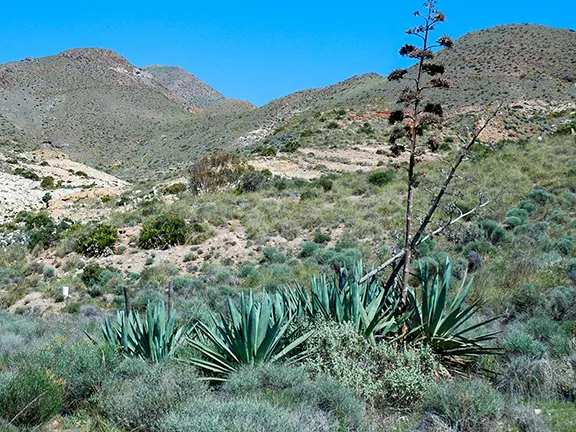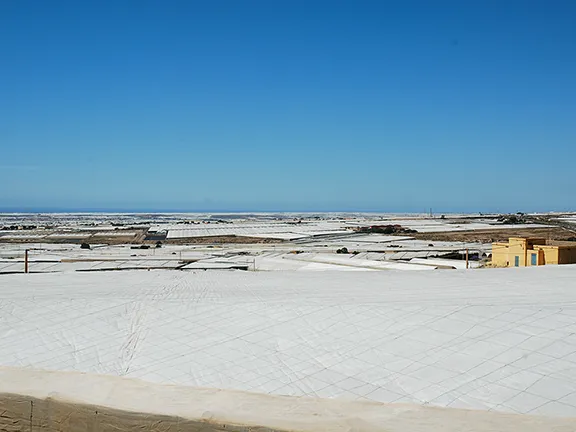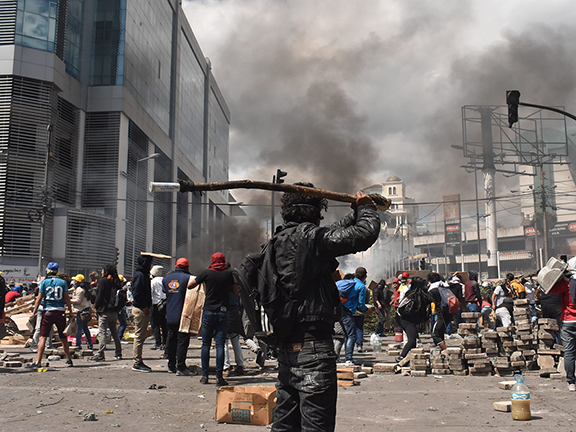The Plastic Revolution in Almeria
From the Neolithic to the 20th century
From the earliest days of agriculture, the semi arid land in Almeria province has proved a challenge. Methods of sowing, nurturing and harvesting crops and taking surplus produce to market were little changed over the six thousand years between the Neolithic period and the early 20th century.
By Nick Nutter on 2023-07-31 | Last Updated 2025-05-20 | The Plastic Revolution in Almeria
This article has been visited 3,254 times

Campo de Dalias from the Space Station
Campo de Dalias Visible from Space
This project looks at the plastic greenhouses of the Campo de Dalias in Almeria. Did you know that these structures are among the three most easily visible man-made objects from the International Space Station? Surprisingly, they share this distinction with the cooling pond of the Chernobyl Nuclear Power Plant and the Bingham Canyon Mine, not the Great Wall of China as commonly believed. The question on our minds is whether these greenhouses are as harmful to the environment as the decommissioning pond at Chernobyl or as destructive as the massive open-pit mine in Utah. Let's explore the facts and impacts of these plastic greenhouses together.
Do you enjoy my articles? For your reading pleasure, this website does not carry third party ads. You could help me write more articles by buying me a cup of coffee.
Almeria, an arid landscape


An arid landscape in Almeria - Gustavo Gilman 1895
It's fascinating to note that Almeria, the region where the plastic greenhouses are located, has a remarkably arid climate. With some areas receiving less than 200 millimetres of rain per year, most of the province is classified as semi-arid, with some parts even considered true desert, the only such zones in Europe.
Rainfall in Almeria


Rainfall Almeria airport 1995 - 2022
In the area we are looking at, the Campo de Dalias coastal plain, the annual precipitation between 1995 and 2022 values are an average of 191 mm, with maximum values of 350 mm and minimum values of 90 mm. The intra-annual variability is also significant, with values of 0 mm during the dry season and torrential rains that can reach 100 mm/day on occasional rainfall events in autumn. There are inter-annual cycles of 5 to 6 years, as well as dry and wet cycles. At the height of one of these wet cycles, in the year 2009 - 2010, despite heavy groundwater pumping in the area, the groundwater levels rose in general.
In the days of Al-Andalus


Noria in Cabo de Gata
This harsh environment made the area largely unpopulated and uncultivated until the days of al-Andalus when the Muslims brought with them the technology to draw water from aquifers using 'norias' and store it without significant loss to evaporation in covered cisterns called 'aljibes'. The norias came in different types, ranging from the sophisticated wind-powered water pump to the donkey or human-powered water wheel, and ancient aljibes can be seen scattered throughout the landscape today.
Oasis in a Barren Landscape


Oasis near Vicar
This early use of technology allowed people to cultivate land in small, isolated pockets, oasis in a barren landscape like this one that still exists near Vicar.
With the departure of the Muslims and subsequent expulsion or persecution of large sections of the population including Mudejars, Jews, Moriscos and Marranos, many of whom had been agricultural workers, the rural population fell drastically. The ones that remained tended to concentrate more in the fertile areas of southern Spain rather than the semi-arid coastal zones of the southeast. The norias and aljibes in these latter areas fell out of use and the location of the underground aquifers became lost.
Neolithic or 20th Century


Harvesting in 20th century in Almeria - Gustavo Gilman 1901
Another factor to take into account is that, unlike the industrialized nations in Northern Europe, Spain never underwent an agricultural revolution. The country did not have a 'Turnip' Townsend to teach crop rotation techniques nor a Jethro Tull to invent the seed drill. Traditional growing methods and tools remained unchanged for centuries, from the Neolithic period until the middle of the 20th century. This lack of innovation is not a reflection, nor does it imply, that the Spanish farmer was backward.
Even as late as the year 1900, a minority of wealthy landowners in Spain still owned a significant portion of arable land, estimated to be around 70-75%. This system of land ownership had deep historical roots, dating back to the Roman Empire and persisting throughout the medieval period and beyond. In southern Spain the inequality was even greater than 75% and much of the rural population only had work at two periods in the year, at sowing time and at the harvest.
Let the Republic Feed You


Campesina in Almeria - Gustavo Gilman 1895
The concentration of landownership among a small group of wealthy landowners was a major source of social and economic inequality in Spain, with the vast majority of the rural population, including small farmers and landless peasants, living in poverty and struggling to make ends meet.
Efforts to reform the land tenure system and redistribute land more fairly were a key focus of social and political movements in Spain during the early 20th century, including the anarchist and socialist movements. However, progress was slow and uneven, and it would take several decades before significant land reform was implemented in the country. In southern Spain, even during the Second Republic, (1931 to 1939), efforts to improve the living and working conditions of the agricultural workers who were little more than feudal serfs, were blocked by the landowners who had a phrase they used if any of their serfs had the temerity to complain, "Let the Republic feed you". The landowners clearly did not want to spend any money on their agricultural workers or on any technological improvements.
No Modernisation


Ox cart in Almeria about 1896
This attitude also removed any incentive for the serf to improve his own position by improving agricultural techniques, he would simply have been enriching his feudal master for no recompense.
Rural Life early 20th century


On the way to market - Gustavo Gilman 1901
At the end of the 19th century and well into the first half of the 20th century, rural life in Almeria continued as it had for hundred, even thousands, of years.


The market in Almeria - Gustavo Gilman 1901
This lack of modernization in agriculture makes the innovative plastic greenhouses of the Campo de Dalias in Almeria all the more remarkable. These greenhouses have revolutionized farming in Spain, allowing for year-round cultivation and significantly increasing crop yields. However, the question remains whether this modernization has come at a cost to the environment and local communities.
Creation of Today's Landscape


Abandoned mining village Almeria - Marchalisco Vinicas
The formation of the semi-desert landscape that we see today took place mainly during the 19th century as result of the mining activities that were accompanied by large wood consumption, agricultural expansion, and demographic growth. Between 1822 and 1857 the growth of the population in Almeria accelerated in an unprecedented manner. Exhaustion of natural resources in Almeria caused desertification. The expansion of irrigated agricultural land, in order to nourish the incoming workers, caused the depletion of surface water. From 1880 onwards, the fall in the prices of mineral and traditional agricultural products and the crisis this generated, forced populations to migrate. Deserted villages in a desert landscape.
References
Agronomy (2021). 'The Role of Technology in Greenhouse Agriculture: Towards a Sustainable Intensification in Campo de Dalias (Almeria, Spain)'
Cynthia Giagnocavo (2012). The Almeria Agricultural Cooperative Model: creating successful economic and social communities
Pulido-Bosch, Antonio, Angela Vallejos, Fernando Sola, and Luis Molina. 2020. "Groundwater Sustainability Strategies in the Sierra de Gador-Campo de Dalias System, Southeast Spain" Water 12, no. 11: 3262.
Do you enjoy my articles? For your reading pleasure, this website does not carry third party ads. You could help me write more articles by buying me a cup of coffee.
 2: Subsistence Agriculture
2: Subsistence Agriculture 3: The Almeria Model
3: The Almeria Model 4: Migrant Workers
4: Migrant Workers 5: The Future
5: The Future